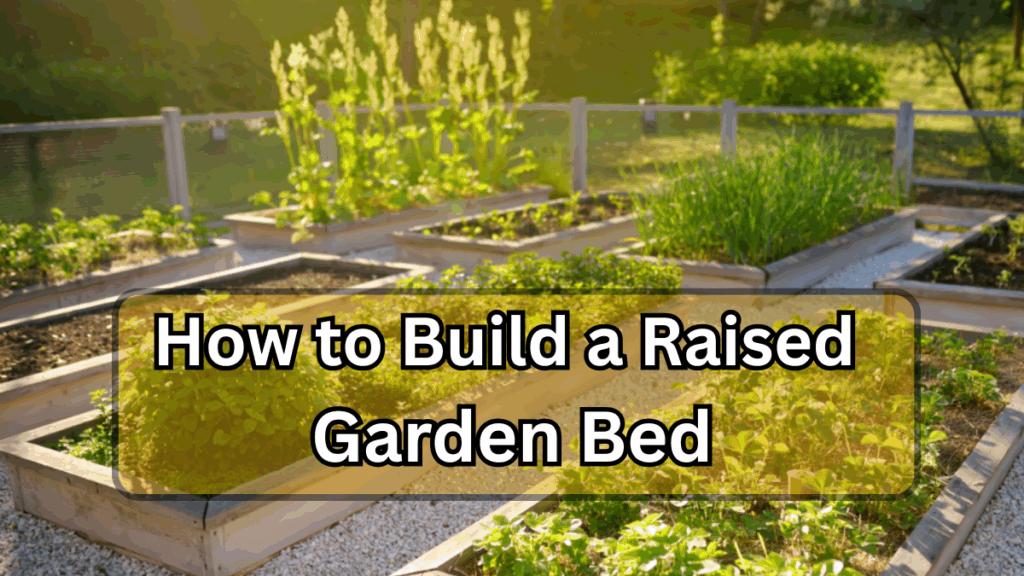If you’ve been thinking about growing your own vegetables, herbs, or flowers, a raised garden bed is one of the most effective ways to get started. Not only does it improve soil drainage and aeration, but it also makes gardening easier on your back and knees. This step-by-step guide will walk you through everything—from planning to planting—so you can build a raised garden bed with confidence.

Why Choose a Raised Garden Bed?
Raised beds have become increasingly popular among gardeners for several reasons:
-
Better soil control: You can create the perfect soil mix for your plants.
-
Improved drainage: Avoid waterlogging and root rot.
-
Weed reduction: Raised beds are easier to maintain.
-
Accessibility: Easier for seniors and those with limited mobility.
-
Extended growing season: Soil warms faster in spring.
Step 1: Plan Your DIY Raised Bed
Before buying materials, it’s important to decide the dimensions, location, and purpose of your raised bed.
Dimensions
-
Standard height: 12–24 inches (30–60 cm)
-
Width: 3–4 feet (90–120 cm) for easy reach
-
Length: Any length depending on space
Location
-
Full sun for most vegetables
-
Flat, well-drained area
-
Easy access for watering and maintenance
Step 2: Choose Your Materials
Common materials for raised beds include:
| Material | Pros | Cons |
|---|---|---|
| Wood (cedar, redwood) | Natural look, durable | Higher initial cost |
| Recycled wood | Eco-friendly, cost-effective | May contain chemicals |
| Metal | Modern look, long-lasting | Can heat soil quickly |
| Concrete blocks | Durable, customizable | Heavy and permanent |
Tip: Avoid treated wood that may leach harmful chemicals into your vegetables.
Step 3: Calculate Cost & Gather Tools
Knowing the approximate cost beforehand will help you stay on budget. Here’s a rough estimate for a 4×4 ft wooden raised bed:
| Item | Estimated Cost (INR) |
|---|---|
| Cedar wood planks | 1,500–2,000 |
| Screws & brackets | 200–300 |
| Drill & saw (if not owned) | 1,500 |
| Soil & compost | 1,200–1,500 |
| Total | ~4,400–5,300 |
Tools Needed:
-
Drill
-
Saw
-
Measuring tape
-
Level
-
Gloves
Step 4: Assemble Your Raised Bed
Now comes the fun part: assembly!
-
Cut your boards to the desired dimensions.
-
Construct the frame:
-
Attach the corners with screws and brackets.
-
Use a level to ensure even height.
-
-
Optional reinforcement: Add corner stakes for extra stability.
-
Position the bed at the chosen location.
A well-built bed should be sturdy and level to ensure proper water drainage.
Step 5: Prepare the Soil Mix (Soil Recipe)
Creating a healthy soil environment is key to a thriving raised bed. Here’s a recommended soil recipe:
| Component | Percentage |
|---|---|
| Garden soil | 40% |
| Compost | 30% |
| Coconut coir or peat moss | 20% |
| Perlite or vermiculite | 10% |
Tips for filling:
-
Layer the soil evenly.
-
Water thoroughly to help it settle.
-
Consider adding slow-release organic fertilizers.
Step 6: Plant Your Garden
-
Choose plants suited to your climate and season.
-
Use companion planting techniques to improve growth.
-
Water regularly, but avoid overwatering.
-
Mulch the surface to retain moisture and prevent weeds.
Step 7: Maintain Your Raised Bed
-
Regularly check for weeds and pests.
-
Rotate crops each season for healthy soil.
-
Replenish compost and organic matter annually.
With proper care, your raised bed can last for many years and provide bountiful harvests.
FAQs About Building a Raised Garden Bed
Q1. What are the ideal dimensions for a raised garden bed?
Typically, 12–24 inches in height, 3–4 feet in width, and any desired length. Width ensures you can reach the center easily without stepping on the soil.
Q2. How much does it cost to build a raised garden bed?
Depending on materials, a 4×4 ft wooden bed can cost around INR 4,000–5,500 including soil and tools.
Q3. Can I use any soil in a raised bed?
It’s best to use a mix of garden soil, compost, coconut coir/peat moss, and perlite or vermiculite to ensure good drainage and fertility.
Click here to learn more
